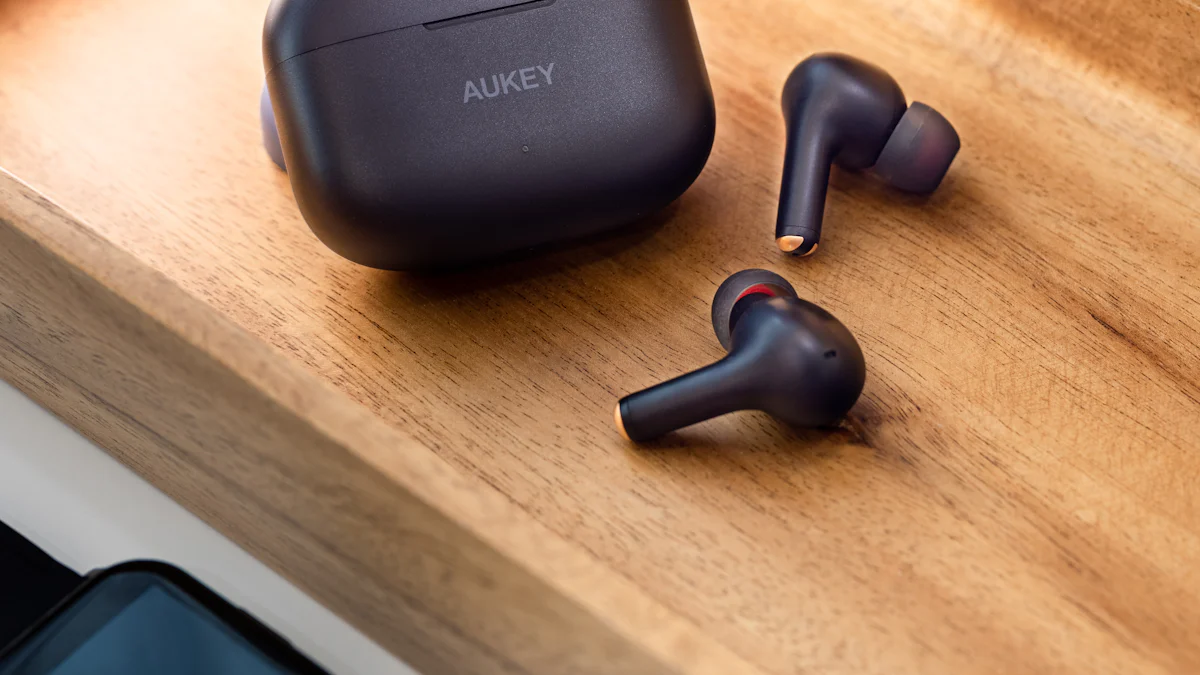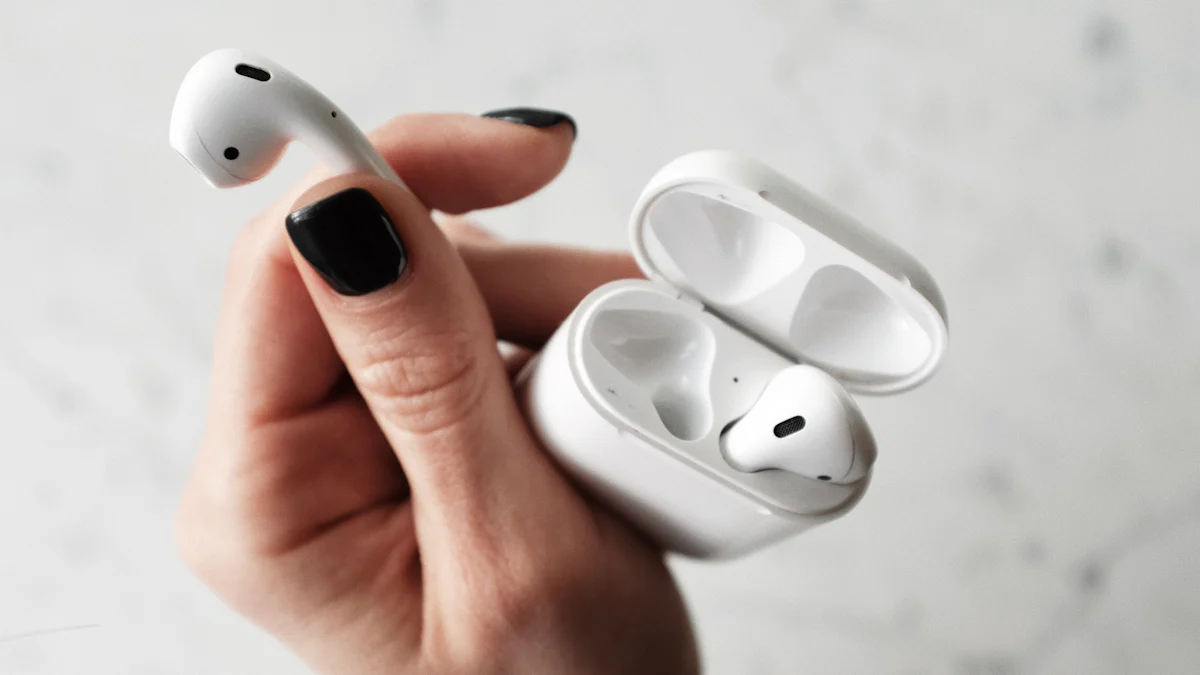Which Noise Cancellation is Best for Travel: ANC or ENC?

When you're traveling, the constant hum of engines or chatter in crowded spaces can be overwhelming. This is where ANC steps in to create a peaceful bubble by actively canceling out unwanted noise. It lets you enjoy your music or podcasts without cranking up the volume, which also protects your hearing. On the other hand, ENC focuses on making your voice crystal clear during calls by filtering out background noise. While both technologies serve unique purposes, understanding *how to choose the right microphone with noise cancellation for travel* depends on whether you prioritize immersive listening or seamless communication.
Key Takeaways
- Active Noise Cancellation (ANC) is ideal for travelers seeking immersive listening experiences, as it effectively reduces ambient noise, allowing you to enjoy music or podcasts without distractions.
- Environmental Noise Cancellation (ENC) enhances voice clarity during calls, making it perfect for communication in noisy environments like airports or crowded cafes.
- When choosing between ANC and ENC, consider your primary use case: ANC for peaceful listening and clear conversations for clear conversations.
- Battery life is a crucial factor; ANC can drain your device's battery faster, so plan accordingly for long trips with limited charging options.
- Invest in high-quality devices for both ANC and ENC to ensure optimal performance, as the effectiveness of these technologies relies on the quality of the microphones and processors.
- For versatility, consider hybrid devices that combine both ANC and ENC, allowing you to switch between immersive audio and clear communication as needed.
- Budget-conscious travelers should prioritize their primary need—whether it's sound quality or communication clarity—when selecting between ANC and ENC options.
Understanding Active Noise Cancellation (ANC)

How Active Noise Cancellation Works
Active noise cancellation uses advanced technology to reduce unwanted sounds around you. It works by detecting ambient noise through tiny microphones embedded in your device. These microphones pick up the background noise and send the data to a processor. The processor then generates sound waves that are the exact opposite of the detected noise. When these opposite waves meet the original noise, they cancel each other out. This process, known as destructive interference, creates a quieter environment for you to enjoy your audio.
ANC is particularly effective at reducing low-frequency sounds like the hum of an airplane engine or the rumble of a train. It actively monitors the surrounding noise and adjusts in real-time to maintain its effectiveness. This makes it a game-changer for travelers who want to escape the chaos of noisy environments.
Benefits of ANC for Travel Microphones
ANC offers several advantages that make it ideal for travel. First, it allows you to enjoy your music, podcasts, or audiobooks without needing to increase the volume. This not only enhances your listening experience but also protects your hearing from potential damage caused by loud audio levels.
Second, ANC creates an Active Noise Canceling immersive audio environment.
Finally, ANC improves the overall quality of audio playback. By reducing background noise, it ensures that every note, word, or beat comes through clearly. This makes it a favorite among travelers who prioritize high-quality sound during their journeys.
Limitations of ANC in Travel Scenarios
While ANC is impressive, it does have its limitations. It works best with consistent, predictable noises like engine hums or air conditioning. However, it may struggle with sudden or irregular sounds, such as people talking or babies crying. These types of noises are harder for the technology to cancel effectively.
Another limitation is battery consumption. ANC requires power to function, which can drain your device's battery faster. This might be inconvenient during long trips where charging options are limited. Additionally, some users may experience a slight pressure sensation in their ears when using ANC, which can be uncomfortable for extended periods.
Despite these drawbacks, ANC remains a top choice for travelers seeking peace and quiet. Understanding its strengths and weaknesses can help you decide if it's the right fit for your travel needs.
Understanding Environmental Noise Cancellation (ENC)
How Environmental Noise Cancellation Works
Environmental noise cancellation uses advanced technology to enhance your voice during calls. It relies on multiple microphones to detect and isolate background noise. Once the system identifies the unwanted sounds, it filters them out, leaving only your voice to be transmitted. This ensures that the person on the other end hears you clearly, even if you're in a noisy environment.
ENC focuses on improving voice clarity rather than blocking out all surrounding noise. It’s particularly useful in situations where communication is key, like phone calls or video conferences. Whether you're in a bustling airport or a crowded café, this technology ensures your voice stands out, making conversations smoother and more effective.
Benefits of ENC for Travel Microphones
ENC offers several advantages that make it a valuable tool for travelers. Here’s why you might find it useful:
- Clearer Communication: ENC ensures your voice is crisp and easy to understand. This is especially helpful during calls in noisy places like train stations or busy streets.
- Enhanced Call Quality: By reducing background noise, ENC improves the overall quality of your calls. Both you and the person you're speaking with will notice the difference.
- Versatility: ENC works well for various scenarios, including phone calls, video meetings, and voice recordings. It’s a reliable choice for travelers who need to stay connected on the go.
This technology shines in environments where background noise could interfere with your ability to communicate. If you often find yourself making calls in public spaces, ENC can be a game-changer.
Limitations of ENC in Travel Scenarios
While ENC has its strengths, it’s not without its drawbacks. Understanding these limitations can help you decide if it’s the right choice for your travel needs:
- Limited Noise Blocking: Unlike ANC, ENC doesn’t cancel out ambient noise for your ears. It focuses solely on improving your voice clarity, so you’ll still hear the surrounding sounds.
- Dependence on Microphone Quality: The effectiveness of ENC depends on the quality of the microphones in your device. Lower-quality microphones may not deliver the same level of performance.
- Not Ideal for Immersive Listening: If your goal is to enjoy music or podcasts without distractions, ENC won’t provide the same experience as ANC. It’s designed for communication, not audio immersion.
Despite these limitations, ENC remains a strong contender for travelers who prioritize clear communication. It’s a practical solution for staying connected, even in challenging environments.
ANC vs. ENC: How to Choose the Right Microphone with Noise Cancellation for Travel

Comparing Effectiveness in Travel Scenarios
When it comes to travel, both ANC and ENC excel in different areas. ANC stands out for its ability to create a serene environment by actively reducing ambient noise. It’s particularly effective against constant low-frequency sounds like the hum of airplane engines or the rumble of a train. This makes ANC a favorite for travelers who want an uninterrupted listening experience. Whether you’re using noise-cancelling headphones or the top ANC earbuds, this technology ensures you can immerse yourself in your music or podcasts without distractions.
ENC, on the other hand, focuses on enhancing voice clarity during calls. It filters out background noise so the person on the other end hears you clearly, even in noisy environments like airports or busy streets. While ENC doesn’t block out noise for your ears, it ensures your communication remains smooth and effective. If you often make calls while traveling, the top ENC earbuds can be a game-changer for maintaining call quality.
In short, ANC improves your listening experience by reducing environmental noise, while ENC enhances communication quality by isolating your voice. Your choice depends on whether you prioritize immersive sound or clear conversations during your travels.
Key Factors to Consider
Choosing between ANC and ENC requires you to evaluate your travel needs. Here are some key factors to help you decide:
-
Primary Use Case: If you value a peaceful listening experience, ANC is the way to go. It’s ideal for enjoying music, audiobooks, or podcasts in noisy settings. For those who need clear communication during calls, ENC offers better voice clarity.
-
Type of Noise: ANC works best for constant, predictable noises like engine hums. ENC shines in environments with varying background sounds, ensuring your voice remains the focus during calls.
-
Battery Life: ANC requires power to function, which can drain your device’s battery faster. If you’re on long trips with limited charging options, this might be a concern. ENC, being less power-intensive, could be a more practical choice in such scenarios.
-
Device Quality: The effectiveness of both technologies depends on the quality of your device. High-quality noise-cancelling headphones or earbuds with ANC deliver superior sound quality. Similarly, ENC performs best with devices equipped with advanced microphones.
-
Budget: ANC technology is often found in premium devices, which might be pricier. ENC, while also effective, is available in a wider range of budget-friendly options.
By considering these factors, you can make an informed decision about how to choose the right microphone with noise cancellation for travel.
Practical Recommendations for Travelers
To help you get the most out of your travel experience, here are some practical tips:
-
For Immersive Listening: Invest in the top ANC earbuds or noise-cancelling headphones. These devices not only enhance sound quality but also provide a quieter environment, making them perfect for long flights or train rides.
-
For Clear Communication: Look for the top ENC earbuds if you frequently make calls in noisy places. These earbuds ensure your voice remains clear, even in challenging environments.
-
For Versatility: If you want a balance between listening and communication, consider hybrid devices that combine ANC and ENC. These offer the best of both worlds, allowing you to switch between immersive listening and clear calls as needed.
-
For Budget-Friendly Options: If cost is a concern, prioritize your primary need. Opt for ANC if you want better sound quality and ENC if clear communication is your goal. Many affordable earbuds cater to specific needs without compromising too much on quality.
Ultimately, the right choice depends on your travel habits and preferences. Whether you’re seeking peace and quiet or seamless communication, there’s a noise-cancellation solution tailored to your needs.
When it comes to travel, anc stands out as the go-to choice for creating a peaceful listening experience. It effectively reduces ambient noise, allowing you to focus on your music or podcasts without distractions. If you’re someone who values immersive audio during flights or train rides, anc delivers unmatched performance. On the other hand, if clear communication during calls is your priority, ENC ensures your voice remains sharp and audible in noisy environments. Ultimately, your decision should align with your specific travel needs, whether it’s enjoying serene audio or staying connected with crystal-clear calls.
FAQ
Which is better for travel, ANC or ENC?
There’s no definitive answer to this question because both ANC and ENC excel in different areas. ANC works best for reducing ambient noise, making it ideal for immersive listening during flights or train rides. ENC, on the other hand, enhances voice clarity during calls, which is perfect for staying connected in noisy environments. If you want the best of both worlds, consider devices that combine ANC and ENC.
Can I use ANC and ENC together?
Yes, some advanced headphones and earbuds offer both ANC and ENC technologies. These hybrid devices let you switch between immersive listening and clear communication, depending on your needs. They’re a great choice if you want versatility during your travels.
Does ANC completely block out all noise?
ANC significantly reduces consistent, low-frequency sounds like engine hums or air conditioning. However, it doesn’t completely eliminate all noise. Sudden or irregular sounds, such as people talking or babies crying, may still be audible. While it creates a quieter environment, it’s not total silence.
Is ENC only useful for phone calls?
ENC is primarily designed to enhance voice clarity during calls, but it’s also useful for video meetings, voice recordings, and even gaming.
Does ANC drain battery faster than ENC?
Yes, ANC requires more power to function because it actively processes and cancels out ambient noise. This can lead to faster battery drain compared to ENC, which is less power-intensive. If you’re on long trips, consider carrying a portable charger or choosing devices with longer battery life.
Are ANC headphones more expensive than ENC ones?
Generally, ANC technology is found in premium devices, which tend to be pricier. ENC, while effective, is often available in a wider range of budget-friendly options. If cost is a concern, prioritize your primary need—immersive listening or clear communication—and choose accordingly.
Can ENC improve my listening experience?
ENC focuses on voice clarity rather than blocking out noise for your ears. It won’t enhance your music or podcast experience the way ANC does. If your goal is immersive listening, ANC is the better choice.
Do I need high-quality devices for ANC and ENC to work effectively?
Yes, the performance of both ANC and ENC depends on the quality of your device. High-quality headphones or earbuds with advanced microphones and processors deliver superior results. Investing in reputable brands ensures you get the most out of these technologies.
Are there any health concerns with using ANC?
Some users report feeling a slight pressure sensation in their ears when using ANC, which can be uncomfortable during extended use. This sensation is harmless and usually fades over time. If it persists, consider taking breaks or adjusting the ANC settings.
What should I choose if I want both immersive listening and clear calls?
If you need both features, look for hybrid devices that combine ANC and ENC. These options let you enjoy high-quality audio while also ensuring clear communication. They’re perfect for travelers who want flexibility without compromising on performance.
See Also
Comparing EMEET Meeting Capsule And Meeting Owl Cameras
Jabra PanaCast 50 Or Coolpo AI Huddle PANA: Which Wins?
Discovering The Perfect Video Conferencing Camera For Meetings
